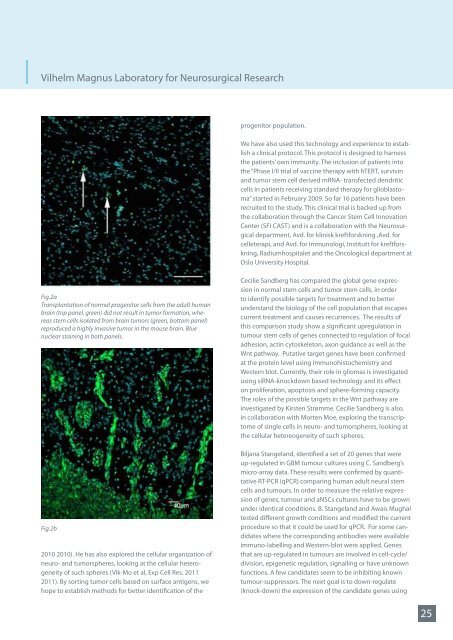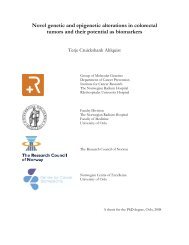Preface - Ous-research.no
Preface - Ous-research.no
Preface - Ous-research.no
Create successful ePaper yourself
Turn your PDF publications into a flip-book with our unique Google optimized e-Paper software.
Vilhelm Magnus Laboratory for Neurosurgical Research<br />
neural stem cells of the adult human brain. Håvard Ølstørn<br />
demonstrated that stem cells isolated from tumors could<br />
reproduce those tumors in immu<strong>no</strong>deficient mice, whereas<br />
stem cells from <strong>no</strong>rmal human brain did <strong>no</strong>t result in tumors<br />
(Fig. 2) (Varghese M et al Neurosurgery, 2008).<br />
Both <strong>no</strong>rmal and tumor stem cells showed a high proliferation<br />
rate when cultured to do so. Interestingly, the<br />
proliferation rate fell dramatically also in tumor stem cells<br />
when they were induced to differentiate. Normal and tumor<br />
stem cells showed a similar pattern of differentiation, i.e. in<br />
neuronal and glial directions, although differentiated cells<br />
from the tumor were clearly ab<strong>no</strong>rmal morphologically and<br />
differentiation in itself progressed much faster. Einar Vik-Mo<br />
has performed a number of experiments studying the effect<br />
that in vitro culture of tumor stem cells has on the cells’<br />
ability to form tumors, to differentiate and to undergo ge<strong>no</strong>typic<br />
and expressional changes (Vik-Mo et al, Neuro Oncol.<br />
Fig.2a<br />
Transplantation of <strong>no</strong>rmal progenitor cells from the adult human<br />
brain (top panel, green) did <strong>no</strong>t result in tumor formation, whereas<br />
stem cells isolated from brain tumors (green, bottom panel)<br />
reproduced a highly invasive tumor in the mouse brain. Blue<br />
nuclear staining in both panels.<br />
Fig.2b<br />
2010 2010). He has also explored the cellular organization of<br />
neuro- and tumorspheres, looking at the cellular heterogeneity<br />
of such spheres (Vik-Mo et al, Exp Cell Res. 2011<br />
2011). By sorting tumor cells based on surface antigens, we<br />
hope to establish methods for better identification of the<br />
progenitor population.<br />
We have also used this tech<strong>no</strong>logy and experience to establish<br />
a clinical protocol. This protocol is designed to harness<br />
the patients’ own immunity. The inclusion of patients into<br />
the “Phase I/II trial of vaccine therapy with hTERT, survivin<br />
and tumor stem cell derived mRNA- transfected dendritic<br />
cells in patients receiving standard therapy for glioblastoma”<br />
started in February 2009. So far 16 patients have been<br />
recruited to the study. This clinical trial is backed up from<br />
the collaboration through the Cancer Stem Cell In<strong>no</strong>vation<br />
Center (SFI CAST) and is a collaboration with the Neurosurgical<br />
department, Avd. for klinisk kreftforskning ,Avd. for<br />
celleterapi, and Avd. for immu<strong>no</strong>logi, Institutt for kreftforskning,<br />
Radiumhospitalet and the Oncological department at<br />
Oslo University Hospital.<br />
Cecilie Sandberg has compared the global gene expression<br />
in <strong>no</strong>rmal stem cells and tumor stem cells, in order<br />
to identify possible targets for treatment and to better<br />
understand the biology of the cell population that escapes<br />
current treatment and causes recurrences. The results of<br />
this comparison study show a significant upregulation in<br />
tumour stem cells of genes connected to regulation of focal<br />
adhesion, actin cytoskeleton, axon guidance as well as the<br />
Wnt pathway. Putative target genes have been confirmed<br />
at the protein level using immu<strong>no</strong>histochemistry and<br />
Western blot. Currently, their role in gliomas is investigated<br />
using siRNA-k<strong>no</strong>ckdown based tech<strong>no</strong>logy and its effect<br />
on proliferation, apoptosis and sphere-forming capacity.<br />
The roles of the possible targets in the Wnt pathway are<br />
investigated by Kirsten Strømme. Cecilie Sandberg is also,<br />
in collaboration with Morten Moe, exploring the transcriptome<br />
of single cells in neuro- and tumorspheres, looking at<br />
the cellular hetereogeneity of such spheres.<br />
Biljana Stangeland, identified a set of 20 genes that were<br />
up-regulated in GBM tumour cultures using C. Sandberg’s<br />
micro-array data. These results were confirmed by quantitative<br />
RT-PCR (qPCR) comparing human adult neural stem<br />
cells and tumours. In order to measure the relative expression<br />
of genes, tumour and aNSCs cultures have to be grown<br />
under identical conditions. B. Stangeland and Awais Mughal<br />
tested different growth conditions and modified the current<br />
procedure so that it could be used for qPCR. For some candidates<br />
where the corresponding antibodies were available<br />
immu<strong>no</strong>-labelling and Western-blot were applied. Genes<br />
that are up-regulated in tumours are involved in cell-cycle/<br />
division, epigenetic regulation, signalling or have unk<strong>no</strong>wn<br />
functions. A few candidates seem to be inhibiting k<strong>no</strong>wn<br />
tumour-suppressors. The next goal is to down-regulate<br />
(k<strong>no</strong>ck-down) the expression of the candidate genes using<br />
25
















